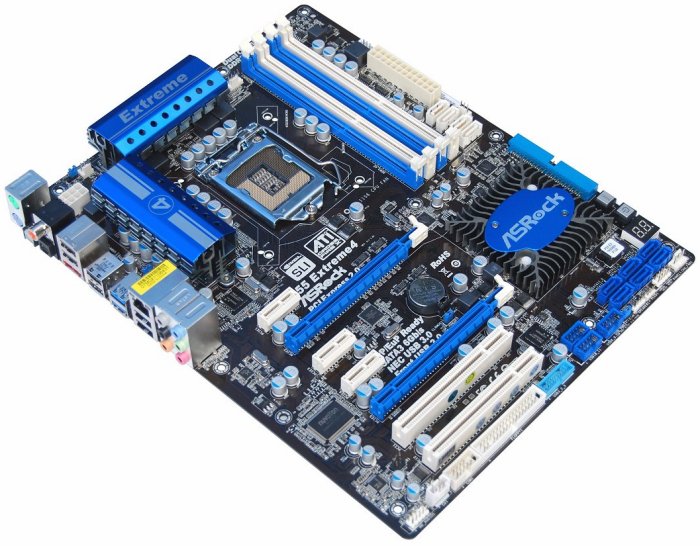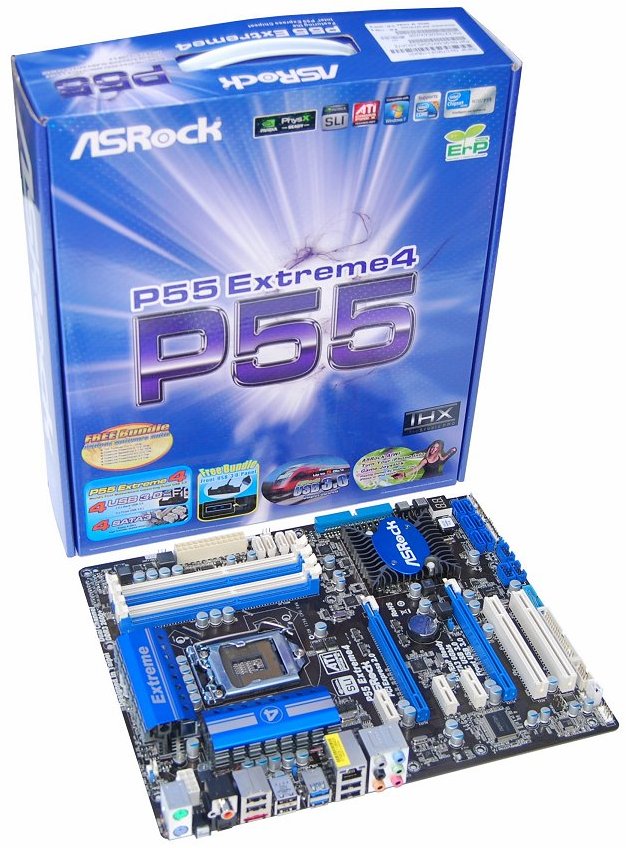Board Design & Layout
If you are coming from a P45 motherboard you'll undoubtedly notice that the P55 platform gets a more compact cooling treatment. Although the P55 chipset is still built using a 65nm process, as was the P45, its TDP rating has been reduced to a mere 4.7 watts compared to the ~22 watts on the older platform.


The P55 is far less complex as it doesn't carry a memory controller, which takes up a vast amount of space within the chip's package. Much of what the north bridge traditionally does has been removed and as a result Intel has integrated the functions of the north and south bridge chipsets into a single chip, which they call a Platform Controller Hub (PCH).




The heatsink on top of the P55 chip measures 7 x 7cm and is just 1cm tall. The die surface of the P55 chipset – or Platform Controller Hub, if you will – measures roughly 1 x 1cm, so the actual bulk of the heatsink is about 3 x 3cm. The larger heatsinks can be found cooling the board's power circuitry 8cm long, 3.5cm wide and 3cm tall. There are two of these heatsinks and each one cools 10 MOSFETs, which are part of the board's 8 + 2 power phase.

In terms of expansion almost all P55 motherboards will support at least two PCI Express x16 slots, while many will feature three. In this case the Asrock P55 Extreme4 provides gamers with a pair PCIe x16 slots, though it is important to note that using two of these with Crossfire or SLI technology will only provide x8 bandwidth each. Additionally, the P55 Extreme4 features three PCIe x1 slots and two traditional PCI slots.
The primary and secondary PCIe x16 slots have been separated by a pair of PCIe x1 slots to help improve air-flow between dual graphics cards, a design that most motherboard manufacturers today use.

The only problem with the Asrock layout is that it features the CMOS battery between these PCIe x16 slots, making it impossible to access with even one graphics card installed. This is a design flaw that can be found on a number of Asrock motherboards and it is something they seem unwilling to change.


The rest of the P55 Extreme4 board design looks quite good. The 24-pin power connector is well placed in the top right hand corner of the board where it is accompanied by the four SATA 6Gb/s ports. The six SATA 3Gb/s ports are mounted at the bottom of the motherboard to avoid any conflicts with the graphics cards. All ten onboard SATA ports are mounted vertically rather than angled at 90 degrees, though given the placement we have no problem with this.

We liked the P55 Extreme4's ability to use LGA775 and LGA1136 coolers by including both sets of mounting holes. This could potentially save users some money when migrating from an older platform as they may find their current aftermarket heatsink to work with this motherboard.


Looking at the I/O panel we have a pair of legacy PS/2 ports, a CMOS reset button, six USB 2.0 ports, two USB 3.0 ports, eSATA port, LAN port, optical and S/PDIF ports along with six audio jacks. All in all, everything the user could want or need in terms of connectivity will be found on the back of his computer.

With two of the four available USB 3.0 ports located at the I/O panel the remaining ports can be connected using an on-board header. This header is located right next to the USB 2.0 respective connectors on the PCB. With the supplied 3.5" front panel bracket users gain easy access to these ports.

Although the board's appearance is not necessarily important, it does seem to play a role to some consumers. Fortunately, the Asrock P55 Extreme4 is a very cool looking motherboard, especially when compared to the original Asrock P55 Extreme which had a bit of a crazy color scheme.

Overall we are pleased with the design and layout of the Asrock P55 Extreme4. The board's cooling is sufficient, the layout caters well for multi-GPU setups, and the I/O panel provides all the necessary connectivity.
